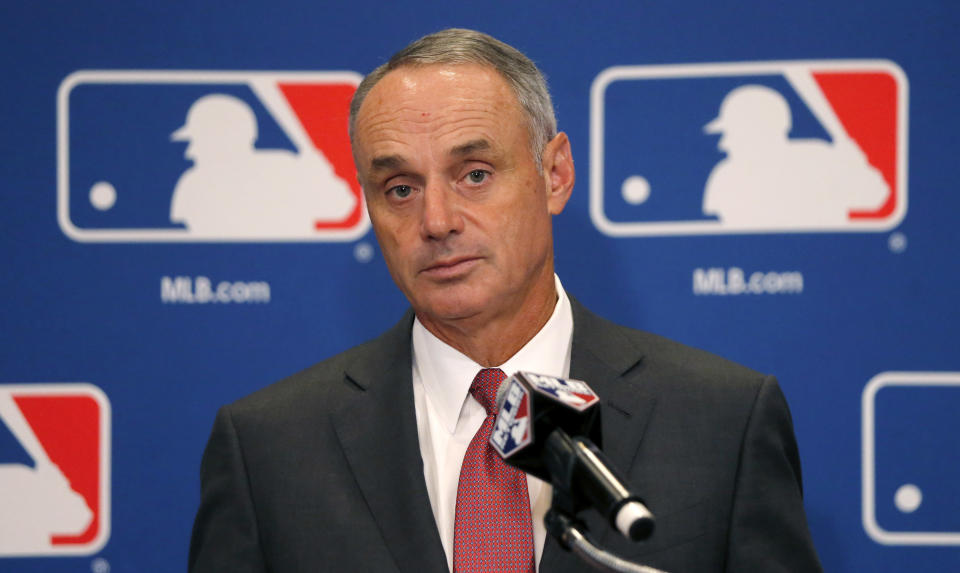Rob Manfred doesn't want automated strike zone now or maybe ever
Umpires have been one of the major storylines of the 2017 baseball season. From CB Bucknor calling a foul tip on a swinging strike to Angel Hernandez ejecting Ian Kinsler for just glancing in his direction, 2017 might be the year of the (bad) umpire. So it’s no surprise that players have responded by renewing their calls for an automated strike zone. Ben Zobrist of the Chicago Cubs is the latest, voicing his support for robot umps after a bad strike three call ended a possible Cubs rally against the Arizona Diamondbacks on Saturday.
[Now’s the time to sign up for Fantasy Football! Join for free]
Commissioner Rob Manfred, while speaking with MLB.com’s Anthony Castrovince, gave his own thoughts on the recent comments about automated strike zones. Castrovince tweeted Manfred’s quote along with some context, and here’s the text:
Electronic strike zone: Though this has been a subject of increased conversation in light of some recent comments from the Cubs’ Ben Zobrist, Manfred does not feel the technology is yet to the point of possible adoption. And he is leery of removing the human element even if/when the technology gets to that point.
“It would be a pretty fundamental change in the game to take away a function that has been performed by our umpiring staff, really with phenomenal accuracy. The fact of the matter is they get them right well over 90 percent of the time.
“And there is a human aspect to that, a work aspect to it that’s always been an important part of our game. I don’t think you can just jump to the conclusion that if you have (the) technology to do it that’s the right thing for your product.”
When Manfred says the tech isn’t yet good enough, he’s not lying. The sheer amount of customization for an automated strike zone would be staggering. Every batter has their own strike zone which would have to be set at the start of the at-bat. But what if the player moves? Or changes his stance slightly in response to a certain pitch? Whatever automation that’s being used would have to catch up and change in response to the player. This isn’t like a Snapchat filter — just because you can put ears and a snout on a video of yourself doesn’t mean that a ball can accurately be tracked in the strike zone. The mechanics of an automated strike zone are exceedingly complicated.

It also seems like the players who are advocating for this are being entirely too trusting of both technology and MLB. Statcast has given players a false sense of security. The way MLB presents Statcast makes it seem like it’s completely right and infallible, but it’s far from it. MLB Advanced Media hasn’t released any of their Statcast data to the public, which means no one else has checked the numbers that they’re constantly throwing at us. They are the only ones controlling the incredible amount of information they get from games, which means no neutral parties have been able to independently verify things like exit velocity. That should make everyone, players included, uncomfortable. If MLB and MLBAM won’t release their data to be verified by third parties, how can they be trusted to put together an accurate, never-fail automated strike zone?
Even though we live in a world of tech, there is very little advanced technology being used during the playing of a baseball game. Pretty much everything is done with two eyes and a human brain. Even the replay reviews that are sent to New York are done by an umpire. He looks at different views of the play and makes a decision. An automated strike zone would be a major, massive change in the game. It’s not as simple as some players are making it out to be. So when players say they want an automated strike zone, you have to peel away the layers to get to what they actually want, and that’s more accountability for umpires.
It can feel excessive to want more accountability when umpires get it right more than 90 percent of the time (according to Manfred). That’s an impressive accuracy rate, but it’s the calls they miss that the players feel the most. Expanded replay can help, but when your game hinges on the human element of umpires making decisions, shouldn’t we know as much as possible about how MLB umpires are trained, evaluated and reprimanded? And it’s hard to know these things when the World Umpire Association’s website is dead and their most recent collective bargaining agreement with MLB (ratified in early 2015) can’t be found on the internet. MLB umpires are shrouded in unnecessary secrecy, at least from the public, and that’s absolutely part of this ongoing issue.
Players can ask for an automated strike zone, but the reality behind it is very complicated. They would be better served getting to the heart of their issues and asking for more umpire accountability. Rob Manfred wouldn’t be able to wave that off with a comment about removing the human element from games. It’s about maintaining and improving the human element, which is entirely achievable.
More MLB coverage from Yahoo Sports:
– – – – – –
Liz Roscher is a writer for Big League Stew on Yahoo Sports. Have a tip? Email her at lizroscher@yahoo.com or follow her on twitter! Follow @lizroscher

 Yahoo Sports
Yahoo Sports 
